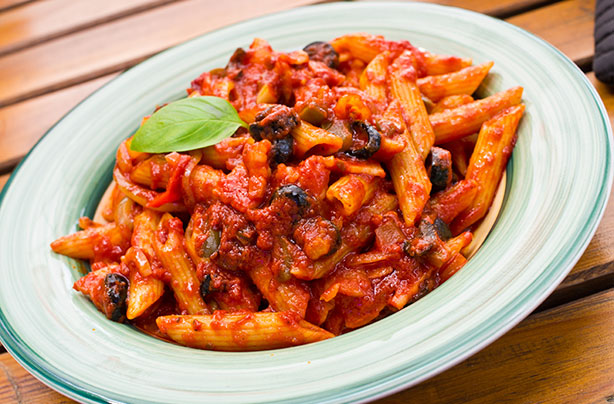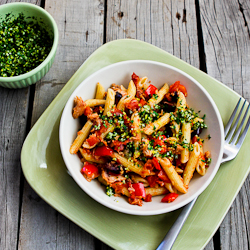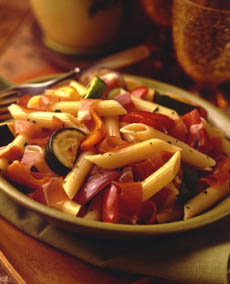| Source: Google.com.pk |
The exact origins of penne alla vodka are unclear; there have been multiple claims to the invention of the dish. According to Pasquale Bruno, Jr., author of The Ultimate Pasta Cookbook, penne alla vodka was invented at Dante, a restaurant in Bologna, Italy. Other historians of the culinary arts recognize James Doty, a graduate of Columbia University, as the inventor of penne alla vodka.
Paula Franzese, an American law professor at Seton Hall University School of Law, has asserted that her father Luigi Franzese, born in Naples, Italy in 1931, devised the first version of penne alla vodka, which he called penne alla Russa because of the addition of the vodka to his tomato and cream sauce base. He allegedly first prepared the dish table side for patrons at the New York City restaurant Orsini in 1973. One of these patrons was Joe Franklin, a celebrated talk show host at the time who fell in love with the dish. Thereafter, he invited Mr. Franzese onto his talk show several times where he would prepare the dish to the delight of guests that included Ernest Borgnine and Cheryl Tiegs, as well as others. Armando Orsini, the owner of the famed restaurant with famous customers, has also verifed the claim.The Williams Sonoma Essentials of Italian cookbook states that it was invented in the 1980s by a Roman chef for a vodka company that wanted to popularize its product in Italy.Recipe Luigi Franzese's Penne with Vodka and Tomato Cream Sauce Ingredients:1 stick butter,1 t olive oil,1 medium onion chopped,2 large cans of crushed tomatoes or Tomato puree,,1 can of water,1 pint of heavy cream or whipping cream,1/2 cup of Vodka,1/4 t red crushed pepper,freshly grated Parmesan cheese,Method:,melt butter & oil in heavy pan over med heat. Add chopped onion and sauted until translucent, 8 minutes, stir,Add tomatoes and cook for 25 minutes (low heat),Add cream, vodka and red pepper. Add one handful of Parmesan cheese to sauce and stir well.Boil until thickened to sauce ( 2 minutes),Only add salt after you taste the sauce, many times you don't need to add salt to sauce.,Cook pasta in large pot of water - add salt to the water - cook al dente,Drain well. Pour sauce over pasta and toss well.,Sprinkle with cheese.Portal icon Spaghetti alla puttanesca (literally "spaghetti of the whore" in Italian) is a tangy, somewhat salty Italian pasta dish invented in the mid-20th century. The ingredients are typical of Southern Italian cuisine: tomatoes, olive oil, olives, capers and garlic.Various accounts exist as to when and how the dish originated, but it likely dates to the mid-twentieth century. The earliest known mention of it is in Raffaele La Capria’s Ferito a Morte (Mortal Wound), a 1961 Italian novel which mentions "spaghetti alla puttanesca come li fanno a Siracusa (spaghetti alla puttanesca as they make it in Syracuse)".The sauce became popular in the 1960s, according to the Professional Union of Italian Pasta Makers.The 1971 edition of the Cucchiaio d’argento (The Silver Spoon), one of Italy's most prominent cookbooks, has no recipe with this name, but two which are similar: The Neapolitan spaghetti alla partenopea, is made with anchovies and generous quantities of oregano; while spaghetti alla siciliana is distinguished by the addition of green peppers.In a 2005 article from Il Golfo—a daily newspaper serving the Italian islands of Ischia and Procida—Annarita Cuomo asserted that sugo alla puttanesca was invented in the 1950s by Sandro Petti, co-owner of Rancio Fellone, a famous Ischian restaurant and nightspot. According to Cuomo, Petti's moment of inspiration came when—near closing one evening—Petti found a group of customers sitting at one of his tables. He was low on ingredients and so told them he didn't have enough to make them a meal. They complained that it was late and they were hungry. "Facci una puttanata qualsiasi," or "Make any kind of garbage," they insisted.a Petti had nothing more than four tomatoes, two olives and some capers—the basic ingredients for the sugo, “So I used them to make the sauce for the spaghetti,” Petti told Cuomo. Later, Petti included this dish on his menu as spaghetti alla puttanesca.The sauce alone is called sugo alla puttanesca in Italian. Recipes may differ according to preferences; for instance the Neapolitan version is prepared without anchovies, unlike the version popular in Lazio, and chili peppers are sometimes added. In most cases, however, the sugo is a little salty (from the capers, olives, and anchovies) and quite fragrant (from the garlic). Traditionally, the sauce is served with spaghetti, although it also goes well with penne, bucatini, linguine and vermicelli.Chopped garlic and anchovies (omitted in the Neapolitan version) are sautéed in olive oil. Chopped chili peppers, olives, capers, diced tomatoes and oregano are added along with salt and black pepper to taste. The cook then reduces this mixture by simmering and pours it over spaghetti cooked al dente. The final touch is a topping of parsley. In this usage, puttanata is an Italian noun meaning something worthless. It derives from the Italian word for whore, puttana.
Penne Pasta Recipes Recipe Of Pasta In Urdu By Chef Zakir In Hindi Salad With White Sauce In Urdu In Indian Style In Red Sauce Photos
Penne Pasta Recipes Recipe Of Pasta In Urdu By Chef Zakir In Hindi Salad With White Sauce In Urdu In Indian Style In Red Sauce Photos
Penne Pasta Recipes Recipe Of Pasta In Urdu By Chef Zakir In Hindi Salad With White Sauce In Urdu In Indian Style In Red Sauce Photos
Penne Pasta Recipes Recipe Of Pasta In Urdu By Chef Zakir In Hindi Salad With White Sauce In Urdu In Indian Style In Red Sauce Photos
Penne Pasta Recipes Recipe Of Pasta In Urdu By Chef Zakir In Hindi Salad With White Sauce In Urdu In Indian Style In Red Sauce Photos
Penne Pasta Recipes Recipe Of Pasta In Urdu By Chef Zakir In Hindi Salad With White Sauce In Urdu In Indian Style In Red Sauce Photos
Penne Pasta Recipes Recipe Of Pasta In Urdu By Chef Zakir In Hindi Salad With White Sauce In Urdu In Indian Style In Red Sauce Photos
Penne Pasta Recipes Recipe Of Pasta In Urdu By Chef Zakir In Hindi Salad With White Sauce In Urdu In Indian Style In Red Sauce Photos
Penne Pasta Recipes Recipe Of Pasta In Urdu By Chef Zakir In Hindi Salad With White Sauce In Urdu In Indian Style In Red Sauce Photos
Penne Pasta Recipes Recipe Of Pasta In Urdu By Chef Zakir In Hindi Salad With White Sauce In Urdu In Indian Style In Red Sauce Photos
Penne Pasta Recipes Recipe Of Pasta In Urdu By Chef Zakir In Hindi Salad With White Sauce In Urdu In Indian Style In Red Sauce Photos










No comments:
Post a Comment